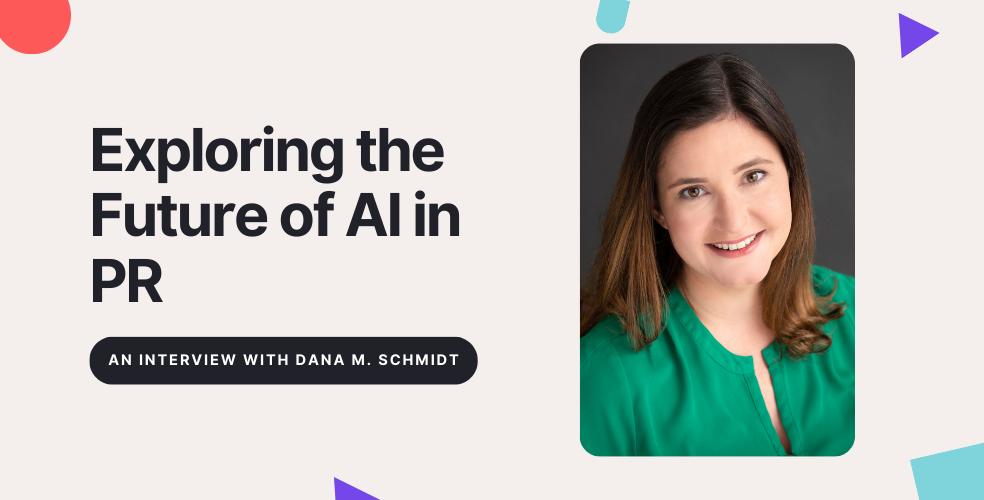 July 15, 2024
July 15, 2024

Exploring the Future of AI in PR: An Interview with Dana M. Schmidt
July 26, 2024
As the communications landscape rapidly evolves, AI technology is increasingly becoming a pivotal tool for industry professionals. We had the pleasure of chatting with Dana M. Schmidt, the Chief Strategy Officer at Slice Communications, who will be speaking at our "AI in PR" Boot Camp from October 17-18 in Chicago. Dana, driven by her passion for digital marketing, champions brand storytelling across social media, PR, and email platforms. Her expertise and insights offer a glimpse into how AI is reshaping the strategies and operations of communication professionals.
Dana's illustrious career has taken her from her hometown in Bucks County to bustling metropolises like New York City and Denver, before bringing her back to Philadelphia. Her exceptional work has not only garnered widespread recognition but also earned her an Emmy award for the “Women and Girls Lead” series at Rocky Mountain PBS. She has shared her knowledge and expertise with digital marketers through esteemed outlets such as Adweek, NBC10, and 6ABC’s Inside Story, and has spoken at several national conferences, including Social Media Day Inc.
In this interview, Dana shares her insights on the concept of "AI cheat codes," the impactful AI tools used at Slice Communications, and the future of AI in the communications field. Her practical advice and real-world examples offer invaluable guidance for communication professionals looking to embrace AI technologies.
Can you explain the concept of "AI cheat codes" in the context of communication professionals?
When we say "AI cheat codes" at Slice Communications, we’re referring to the efficiencies that artificial intelligence introduces. It’s not just about automating mundane, time-consuming tasks - it’s also about analyzing data to make better decisions as communicators. We are using AI like a calculator, in essence. We still need to identify the equation that needs to be inputted, and the solution it produces is just the beginning of our creative process. But now we have more time to prioritize the humanity inherent in communication, like listening to and engaging with our audiences.
What are some of the most impactful AI tools you and your team use beyond ChatGPT?
Most of the software and subscriptions that we’ve relied on for ages have all incorporated AI in the last year. For example, we run our pitches through Grammarly to identify and adjust tone. We use Mention to identify sentiment shifts based on our earned coverage. When it comes to social media management, tools like Hootsuite have incorporated AI to assist with optimal scheduling. And Google Analytics leverages AI to transform raw data into actionable insights. The list goes on - but I’ll be sharing more examples in Chicago this October!
How have these AI tools enhanced your productivity and workflow at Slice Communications?
At Slice Communications, the integration of AI tools has revolutionized productivity and workflow. Using an AI notetaker had one of the biggest impacts: now, we can run Briefly AI or OtterAI in the background of a meeting, and our notes are captured immediately. We don’t lose time combing through for action items or sending individuals to-do’s. All of that work is automated, archived, and accessible.
Can you share specific examples of how these AI tools have provided strategic insights for your communication strategies?
AI-driven sentiment analysis in particular has offered strategic insights to inform communication strategies. For example, the team can monitor public opinion and respond proactively to shifts in sentiment. During a product launch campaign, AI-driven analytics highlighted a surge in positive sentiment related to a specific feature, prompting the team to pivot their messaging to emphasize that feature, resulting in increased engagement.
What criteria do you consider when selecting AI tools to integrate into your existing subscriptions?
When selecting AI tools to integrate into existing subscriptions, there are a few things we consider:
- User-Friendliness: The tool should have an intuitive interface that requires minimal training.
- Cost-Effectiveness: The tool should provide significant value relative to its cost.
- Scalability: The tool must be scalable to accommodate future growth.
- Support and Reliability: 24-hour customer support is preferred, even if it’s in the form of AI chatbots.
How do you ensure that the AI tools you use are effectively embedded into your daily operations?
One of our core values at Slice is “Always Learning.” This means we foster a culture of discovery and experimentation, and we encourage everyone to share their findings with the group. Never is this more evident than when someone is testing out a new tool and shares it through our All Agency channels. Later this year, we plan to develop an AI Taskforce of internal strategists and practitioners, with a goal of creating a system of loose governance and structure.
What are some common challenges you’ve faced when implementing AI tools, and how have you overcome them?
In implementing AI tools, we’ve encountered our fair share of resistance to change. There are also legitimate data privacy concerns, not to mention a learning curve when it comes to safely navigating these tools. But I think we all understand that AI is here to stay, so we choose to embrace it and work with it instead of against it. Much like a calculator, AI frees us up to do bigger, better thinking and, ironically, put people first.
How do you measure the success and impact of AI tools on your communication efforts?
If we incorporate messaging into our campaign based on something we learned from an AI tool, we can measure that impact in increased engagement rates and enhanced sentiment scores. But where we really see the “success metrics'' are in our time-tracking tool, Harvest - where our colleagues are logging less time on manual analysis, note-taking, etc. and more time connecting with clients and audiences. We get to spend our time building bigger, better campaigns.
What advice would you give to communication professionals who are hesitant to adopt AI technologies?
For communication professionals hesitant to adopt AI technologies, start small with a free account. Don’t invest too much time or money until you are really bought in on the problem AI is solving, and what real benefit it’s providing you. And remember, AI is a tool to enhance, not replace, human creativity.
How do you foresee the future of AI in the communications field evolving over the next few years?
As communication professionals, we’re on the frontlines of the AI evolution. We need to be able to spot it, use it, and build on it. Could we all, very soon, live in a world where “Big Brand” Facebook posts are mostly AI-generated? Potentially. But I’m okay with that if it means more thought and expertise is put into genuine community management and reactive social media. If AI creates more time and space for human-to-human connection, count me in.
Join us at the "AI in PR" Boot Camp from October 17-18 in Chicago to hear more from Dana and other industry leaders. Discounted tickets with a $200 discount are available here.